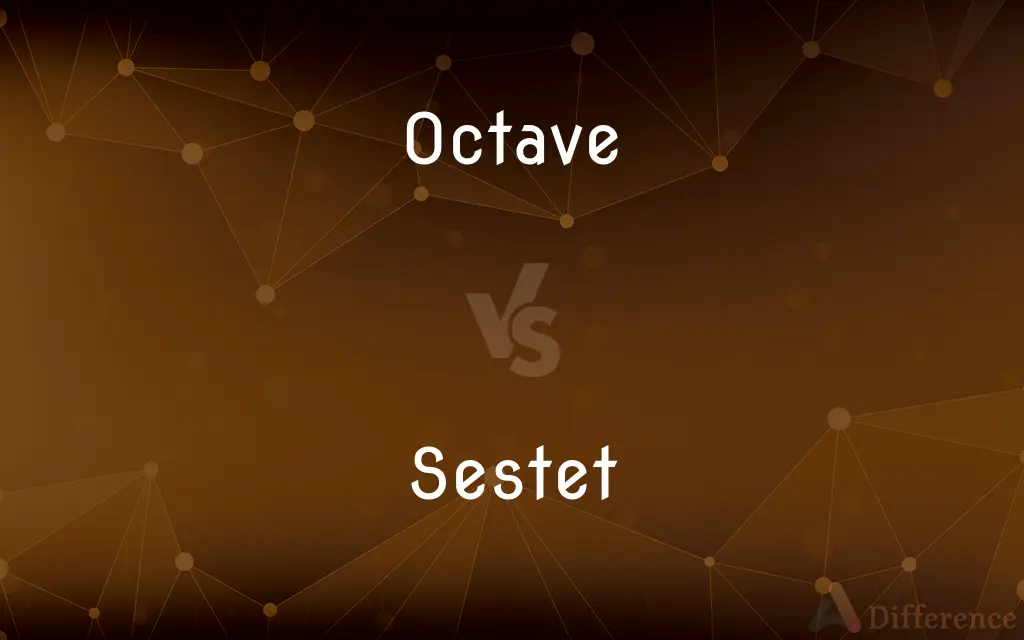Octave vs. Sestet — What's the Difference?
By Urooj Arif & Fiza Rafique — Updated on April 4, 2024
An octave is a set of eight lines in a poem, often forming one part of a sonnet, whereas a sestet comprises six lines, typically serving as the concluding part of a sonnet.

Difference Between Octave and Sestet
Table of Contents
ADVERTISEMENT
Key Differences
An octave, in poetry, especially within the structure of a sonnet, serves as the initial segment, often setting up a problem, argument, or situation. This section typically follows a specific rhyme scheme (such as ABBAABBA in the Italian sonnet). On the other hand, a sestet follows the octave in many sonnet forms, offering a resolution, counterargument, or reflection on the octave's presentation. Its rhyme scheme can vary (CDCDCD or CDECDE are common in Italian sonnets).
While octaves lay the foundation of a discourse within a poem, introducing themes or posing questions, sestets work towards exploring those themes further or providing answers. The transition between an octave and a sestet in a sonnet often marks a volta, or turn in the argument or mood of the poem.
In terms of structural purpose, octaves are crucial for establishing the scope and setting the tone of the poem, creating expectations for the reader. Sestets, while, serve to fulfill those expectations, often leading to a nuanced or enlightening conclusion, underscoring the poet's message or insight.
The effective use of both octaves and sestets in sonnets showcases the poet’s ability to create a compelling argument or narrative within a confined space, demonstrating mastery over language and form. While octaves introduce complexity or conflict, sestets strive for harmony or resolution, reflecting the dual nature of inquiry and understanding in poetry.
Comparison Chart
Line Count
8 lines
6 lines
ADVERTISEMENT
Position
Typically the first part of a sonnet
Follows the octave in a sonnet
Purpose
Introduces a problem, argument, or situation
Provides a resolution, counterargument, or reflection
Rhyme Scheme
ABBAABBA (Italian sonnet) among others
CDCDCD or CDECDE (Italian sonnet) among others
Relationship
Sets the stage for the argument or theme of the poem
Concludes or complements the octave’s presentation
Compare with Definitions
Octave
Utilizes a specific rhyme scheme to structure its lines.
The octave's ABBAABBA scheme emphasizes its lyrical quality.
Sestet
Can feature varied rhyme schemes, adding flexibility.
The poet chose a CDECDE rhyme scheme for the sestet.
Octave
A section of eight lines in a poem, forming one part of a sonnet.
The poem's octave sets up a conflict between love and duty.
Sestet
A six-line stanza or the final six lines of a sonnet.
The sestet resolved the poem’s initial tension with a note of hope.
Octave
Often creates a narrative or argumentative foundation.
In the octave, the speaker recounts a journey of self-discovery.
Sestet
Typically follows an octave and presents a conclusion or counterargument.
The sestet’s contrasting imagery brings clarity to the octave’s questions.
Octave
Serves to introduce the poem's main themes or questions.
The octave questions the nature of happiness.
Sestet
Aids in delivering the poem's message or thematic resolution.
Through the sestet, the poem’s theme of redemption is fully realized.
Octave
Marks the beginning of a traditional sonnet.
The sonnet’s octave beautifully lays the groundwork for its emotional climax.
Sestet
Reflects a shift in tone or perspective from the octave.
The sestet introduces a volta, shifting from despair to optimism.
Octave
In music, an octave (Latin: octavus: eighth) or perfect octave (sometimes called the diapason) is the interval between one musical pitch and another with double its frequency. The octave relationship is a natural phenomenon that has been referred to as the "basic miracle of music," the use of which is "common in most musical systems." The interval between the first and second harmonics of the harmonic series is an octave.
Sestet
A sestet is six lines of poetry forming a stanza or complete poem. A sestet is also the name given to the second division of an Italian sonnet (as opposed to an English or Spenserian Sonnet), which must consist of an octave, of eight lines, succeeded by a sestet, of six lines.
Octave
The interval of eight diatonic degrees between two tones of the same name, the higher of which has twice as many vibrations per second as the lower.
Sestet
A group of six lines of poetry, especially the last six lines of a Petrarchan sonnet.
Octave
A tone that is eight diatonic degrees above or below another given tone.
Sestet
A poem or stanza containing six lines.
Octave
Two tones eight diatonic degrees apart that are sounded together.
Sestet
(poetry) The last six lines of a sonnet, forming two stanzas of three lines each.
Octave
The consonance that results when two tones eight diatonic degrees apart are sounded.
Sestet
The last six lines of a sonnet.
Octave
A series of tones included within this interval or the keys of an instrument that produce such a series.
Sestet
The cardinal number that is the sum of five and one
Octave
An organ stop that produces tones an octave above those usually produced by the keys played.
Sestet
Six performers or singers who perform together
Octave
The interval between any two frequencies having a ratio of 2 to 1.
Sestet
A set of six similar things considered as a unit
Octave
The eighth day after a feast day, counting the feast day as one.
Sestet
A musical composition written for six performers
Octave
The entire period between a feast day and the eighth day following it.
Sestet
A rhythmic group of six lines of verse
Octave
A group or series of eight.
Octave
A group of eight lines of poetry, especially the first eight lines of a Petrarchan sonnet. Also called octet.
Octave
A poem or stanza containing eight lines.
Octave
(Sports) A rotating parry in fencing.
Octave
(music) An interval of twelve semitones spanning eight degrees of the diatonic scale, representing a doubling or halving in pitch frequency.
The melody jumps up an octave at the beginning, then later drops back down an octave.
The singer was known for astounding clarity over her entire five-octave range.
The octave has a pitch ratio of 2:1.
Octave
(music) The pitch an octave higher than a given pitch.
The bass starts on a low E, and the tenor comes in on the octave.
Octave
(music) A coupler on an organ which allows the organist to sound the note an octave above the note of the key pressed (cf sub-octave)
Octave
(poetry) A poetic stanza consisting of eight lines; usually used as one part of a sonnet.
Octave
(fencing) The eighth defensive position, with the sword hand held at waist height, and the tip of the sword out straight at knee level.
Octave
(Christianity) The day that is one week after a feast day in the Latin rite of the Catholic Church.
Octave
(Christianity) An eight-day period beginning on a feast day in the Latin rite of the Catholic Church.
Octave
A small cask of wine, one eighth of a pipe.
Octave
An octonion.
Octave
(signal processing) Any of a number of coherent-noise functions of differing frequency that are added together to form Perlin noise.
Octave
(astrology) The subjective vibration of a planet.
Octave
(obsolete) Consisting of eight; eight in number.
Octave
The eighth day after a church festival, the festival day being included; also, the week following a church festival.
Octave
The eighth tone in the scale; the interval between one and eight of the scale, or any interval of equal length; an interval of five tones and two semitones.
Octave
The first two stanzas of a sonnet, consisting of four verses each; a stanza of eight lines.
With mournful melody it continued this octave.
Octave
A small cask of wine, the eighth part of a pipe.
Octave
Consisting of eight; eight.
Octave
A feast day and the seven days following it
Octave
A musical interval of eight tones
Octave
A rhythmic group of eight lines of verse
Common Curiosities
How important is the rhyme scheme in octaves and sestets?
The rhyme scheme is crucial for the musical quality of the sonnet and for structuring the argument or narrative.
Can the themes in the octave and sestet be completely different?
They are usually related, with the sestet providing resolution or contrast to the octave's themes, though the degree of difference can vary.
What is a volta in poetry?
A volta is a rhetorical shift or dramatic change in thought and emotion in a sonnet, often occurring between the octave and sestet.
Is it easier to write an octave or a sestet?
It depends on the poet’s intent and style. The octave poses a challenge in setting up a compelling argument or theme, while the sestet requires skill in elegantly resolving or reflecting on it.
Can a poem have multiple octaves and sestets?
Yes, longer poems can contain multiple sections that function as octaves and sestets, especially in sequences of sonnets.
Do modern poets still use octaves and sestets?
Yes, while they may employ more freedom in form, many modern poets still use these structures for their expressive potential.
Do all sonnets have octaves and sestets?
Traditional Italian (Petrarchan) sonnets do, but other forms, like the English (Shakespearean) sonnet, have different structures.
What makes a successful transition from an octave to a sestet?
A successful transition smoothly shifts the poem’s focus or mood, often marked by a volta, to enrich the poem's depth and impact.
How do octaves and sestets affect the overall structure of a sonnet?
They provide a clear framework for developing and resolving themes, contributing to the sonnet's emotional and intellectual depth.
Can octaves and sestets exist outside of sonnets?
Yes, they can appear in other poetic forms as standalone stanzas or as part of larger poetic sequences, though they are most closely associated with sonnets.
Share Your Discovery

Previous Comparison
Anywhere vs. Wherever
Next Comparison
Hazardous vs. DangerousAuthor Spotlight
Written by
Urooj ArifUrooj is a skilled content writer at Ask Difference, known for her exceptional ability to simplify complex topics into engaging and informative content. With a passion for research and a flair for clear, concise writing, she consistently delivers articles that resonate with our diverse audience.
Co-written by
Fiza RafiqueFiza Rafique is a skilled content writer at AskDifference.com, where she meticulously refines and enhances written pieces. Drawing from her vast editorial expertise, Fiza ensures clarity, accuracy, and precision in every article. Passionate about language, she continually seeks to elevate the quality of content for readers worldwide.
















































